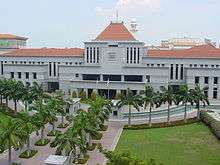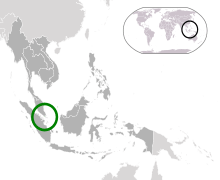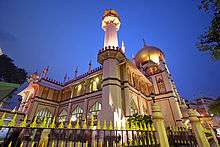Wikijunior:Asia/Singapore
< Wikijunior:Asia.svg.png)
 Singapore
Singapore
Singapore (or The Republic of Singapore, Lion City, oir Garden City/City of Garde) is a country located in Southeast Asia. Singapore was settled in the 2nd century of AD (Anno Domini), and from that point until Modern Singapore was founded in 1819 by Sir Stamford Raffles, Singapore belonged to a lot of local (nearby) empires. The British then obtained Singapore and became a British Colony in 1826.
Occupied by Japan, during World War 2/two, Singapore successfully became independent in 1963. Singapore, since then, developed rapidly, and is one of the most recognized countries, and being recognized as one of the Four Asian Tigers. Lee Kuan Yew (or LKY), is the first prime minister. Lee Kuan Yew was most known for the development of Singapore. Lee Kuan Yew became the first prime minister of Singapore in 1959, governed Singapore for three decades, and then stepped down in 1990. The other prime ministers are Goh Chok Tong and Lee Hsien Loong.
The current minister is Lee Hsien Loong (Singapore has 3 prime ministers, in which Lee Hsien Loong is the 3rd prime minister), and the capital of Singapore is Singapore. You might be thinking "what???", right? Singapore is a city state, and an island country. So, as a city state, Singapore is the capital of Singapore.
Where is Singapore?

Singapore is between the Indian Ocean and South China Sea, located in Southwest Asia, south of the Malay Peninsula. Countries that are near Singapore are Indonesia, Malaysia, and Papa New Guinea. Singapore has more than 60 islands, but the main island is a diamond shaped like island called Singapore (in English), or Pulau Ujong in Malay.
How many people live in Singapore?
Around 5,399 million people live in Singapore (as of 2013), in which 3/5 of the population are citizens. The three main backgrounds in Singapore are Chinese, Indian, and Malay. 76% of the population of Singapore are Chinese. 14% of the population of Singapore are Malay. 7% of the population of Singapore are Indian. And 1.2% of the population of Singapore are other nationalities.
Singapore is a big tourist destination, known for reaching an astonishing 13,171,303 tourists in 2011, over twice of Singapore's population. Generally, 2/5 of the population of Singapore are tourists, and the population changes yearly since tourists enter, and leave, the country.
What are the most common languages in Singapore?
The most common languages in Singapore are English, Mandarin, Malay, and Tamil. In 2009, Singapore has been identified to have over 20 languages spoken in Singapore. Chinese Singaporeans would usually speak English and Mandarin, Malaysian Singaporeans would usually speak English and Malay, and Indian Singaporeans would usually speak English and Tamil. Malay is the National Language of Singapore, but English is more widely spoken. Usually, Singaporeans know more than one language.
What is the most common religion in Singapore?

Buddhism is the most followed religion in Singapore, in which 33.3% of Singapore's population are Buddhists. Atheists cover 17% of the population of Singapore, and Islam is 14.7% of the population of Singapore. Most of the Chinese in Singapore usually are Buddhists (34.8%). Nearly all of Malays would be Muslims (99.6%), and most of Indians in Singapore would be Hindus (55.4%).
What is the sport of Singapore?
Singapore does a lot of sports, for competition, and for recreation. Some of the popular sports are football (soccer), cricket, rugby union, swimming, badminton, basketball, and cycling.
Singapore has a national cricket team that plays international matches. The Singapore National Cricket team has been in the ICC (International Cricket Council), since 1974. The Singapore national cricket team played in the ACC Trophy.
What are some important sights?

- Dalhouise Obeslisk - A needle like architecture in Empress Palace, in the Central Region. This needle in Empress Palace, was built by to mark the second visit by James Andrew, the Governor-General in India, on February 2015. Designed by John T. Thomas, a Government Surveyor and Architect, the Dalhouise Obeslisk was built to remind merchants of free trade. The Dalhouise Obeslisk has been moved twice, the first in the late 1800s due to the expansion of the Padang. The second was in 1891, it was shifted to Victoria Theater. On both sides, there is an inscription in Jawi, Chinese, Tamil, and English.
- Singapore Botanic Gardens - Founded by Sir Stamford Raffles (founder of Singapore) in 1822 in Fort Canning, is a star attraction for the usual traveler. These Gardens were closed in 1829, but reopened in 1859, and the present site of the garden was developed by Agri-Horticultural Society. 15 years later, the garden was given to the government. The gardens is the only botanic garden in the world to be opened from 5am to 12 midnight every day of the year.
- Little India - An ethnic neighborhood, found in Singapore (lies to the east of the Singapore River, across from Chinatown, and north of Kampong Glam). Little India is a great place to explore Tamil culture elements. The local Tamil Community calls Little India "Tekka". Little India is filled with fruit/sweet selling shops, as well as cloth selling shops, to unique stalls selling shoes. The price here is usually quite cheap. Little India is a part of the urban planning area of Rochor. Little India was originally a place for Tamil immigrants to live in. The earliest mosques of Little India are found in Telok Ayer Street and South Bridge Road, the oldest Hindu temples are also found there.
- Merlion Statue - the original Merlion statue being located in Singapore, the Merlion Statue is a 8.6 meter statue of a lion-fish hybrid. The Merlion was originally designed by Fraser Brunner, a curator (a keeper of a museum or other collections) of the Van Kleef Aquarium The Merlion was designed to be the emblem of the Singapore Tourist Board. The lion of the Merlion Statue represents when Prince Sang Nila Utama rediscovered Singapore (or "Lion City") in 11 AD. The fish represents one of Singapore's roots, which is being a fishing village.
| Wikijunior:Asia | |||
|
| |||
